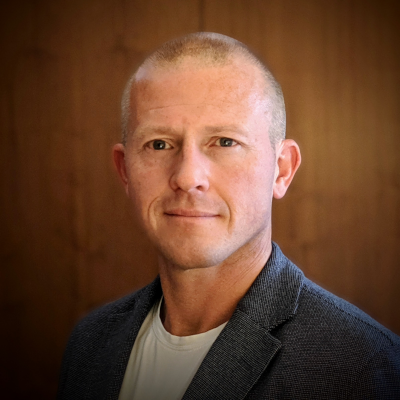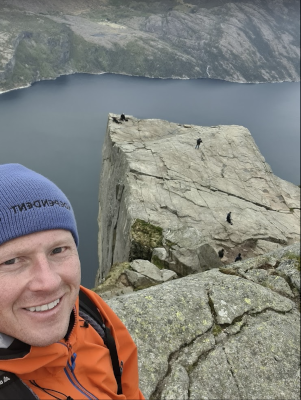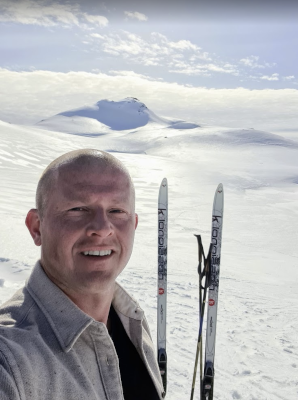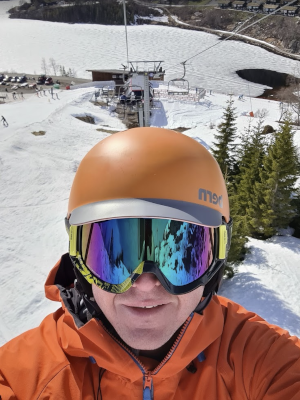Here is today’s summary of the “Campfire Talks with Herbie”.
TameFlow Community Member: Øystein Mehus
Name (and Company/Affiliation if desired)
Who are you?

I guess I’m just a normal middle aged guy living a normal life with my not so normal family in a not so normal country in a less and less “normal” world. Seriously, I am very fortunate to be living in one of the richest countries in the world with a good social system greased by oil money.
I am 48 years old, a single father of four (2x16 and 5 and 6 years olds) that has spent a large portion of my life, age 15-28 more or less working with the purpose to finance skate- and snowboarding trips before picking up my Masters in CSc again in the late 90s only to get a part time job developing industrial control systems, that quickly turned into a 150% position and involved travelling the world - so no Masters degree.
After a few years I transitioned to developing training simulators and worked as a programmer. Whatever I do, I try to do a good job and I quickly get responsibility, so I moved into team lead/programmer/project management and then product management which was my main responsibility until I decided to become a consultant in 2019.
I tend to go a bit extreme in what I do and following my snowboarding years I discovered white beaches and coral reefs and picked up scuba diving. It quickly escalated to diving very deep and also very far into caves. I’m also a keen photographer and used to lag lots of heavy expensive equipment around, but I actually haven’t used the gear since last summer’s Iceland holiday trip.
I don’t think I have a competitive streak in me; I only ever did sports where I “compete” with myself; practice and learn, mastery and control (karate, golf, skate- and snow boarding, scuba diving). This is true also in skills I pick up for work. I spend a lot of time researching and learning, putting different bits into systems that make sense in various situations. I am definitely a generalist rather than a specialist, I like to have an overview and an understanding of the whole, rather than a deep understanding of small parts. This has served me well, especially in product management and systems development.
How did you get involved with Agile, Coaching, Organizational Performance - and in particular with TameFlow?

My introduction to Agile came from Extreme Programming - the name caught my attention when I worked as a junior programmer! It never caught my bosses interest and we never used it , but I followed the Yahoo groups I believe they were. From there I caught an interest in and got introduced to the pattern movement, GoF, and I managed to convince my boss to let me go on a Pattern writing workshop with Alistair Cockburn (or maybe it was James Coplien). I had too little experience to contribute much or even learn much pattern writing, but the people and the conversations in the pub were great.
In 2000 we bid for a large simulations project; fixed scope/time/cost, delivery in 12 months - lots of software and hardware development and I was made project manager. I got a mentor and proceeded with making a traditional project plan, as was still the case back then, especially with us as we were part of a larger project based organization. My plan had something like 650 activities and during execution we had so much work in progress that following up the plan took me 2 days per week. Realizing that we’d fail the delivery; company on the line, I decided to change everything to Scrum overnight and it made things a lot better for everyone. The illusion of control was gone and we could focus on fixing the problems on hand.
I had read Lawrence Leach’s book “Critical Chain Project Management” at this point and picked up on the ideas of estimation and moving the aggregated compressed buffer to the end as protective capacity. I didn’t use buffer signalling for execution tracking, but relied on burndown charts and CFDs to track. At this point 2/3s of our work was fixing defects and only 1/3 productive work, so still estimates were off target, but we felt we had much more control. Everyone put in a lot of overtime and we actually had a person burn out. This affected me quite a lot and I decided our goal for the future should be no overtime, which we managed to stick to for many years following the completion of this project.
Following the conversion to Scrum, with stable teams, our process matured, we ended up dropping the daily meetings, sprint planning and retros and we slowly changed our workflow to kanban and flow. I continued to follow David Anderson’s work from his early Yahoo group to the Agile Management book in 2003 and the blue book in 2008. I got exposed to Tameflow and the Hyperbook quite early and read a lot of Steve’s blog posts. I thought I had read the Hyper book, but checked for something recently and turns out I only made it through chapter 5 so I have again put it on my reading list.
I did my SCM class with Jeff Sutherland in 2006, but most of my learning I get from reading and trying to apply. The product management job in a small company with a global impact requires a lot of work, and even though the desire to get trained and do more of this “Agile” stuff was burning in me, I also enjoyed my job developing new solutions for a global audience a lot and there was no time or budget for training.
Since 2015 I started to get a feeling I shuffled more and more paper and my teams were less and less in need of my input. It got a bit boring and I started thinking of doing something else. Circumstances, family and work meant it took a bit longer, but in 2018 I decided to leave and also started an Executive MBA. Again circumstances in the company kept me in place over summer 2019 when I left and became a consultant in a small Norwegian company with great people, management and culture. That summer I signed up for a Kanban Coaching Masterclass and started the continuation of my Kanban journey that had been on a slow-burner for so many years.
Having read the Tameflow book; after Corona set in, I found Daniel’s course offerings again and signed up for the Boards and TA classes, which I liked very much and I felt like I found a new friend and a great community. The Tameflow book calls for another read-through soon; there are so many new concepts and things to wrap the brain around, but I feel it’s maturing now and my mind is slowly internalizing some of the content.
Are you currently (or do you intend) making a living in this sector? And with TameFlow?
My current position is as a project management consultant; not exactly Agile per se, but I liked the company and the people and figured I’d get to do Agile just about anywhere, so it needn’t be as a coach. This turned out to be true and I got a gig at a medical company called Laerdal, where I lead a DevOps-to-be team.
To help with the team’s goals of delivering frequently, my focus has been to introduce a flow mindset, moving from Scrum towards one-piece flow and I have used a lot of the concepts from Tameflow. We are measuring throughput, have introduced flowtime (wait and touch), and the concept of full-kitting, albeit we don’t call it that; we simply call it Discovery and refer to Ideas and Options. I’ll prepare the introduction of DBR and Throughput Accounting to assist in prioritization and decision making when stakeholders need to start discussing the next initiatives to hit the tarmac,
Give us a typical day in your life!

I get up quite early, wake the kids up, prep breakfast and lunch boxes and get everyone off to kindergarten and school before I drive to work before 8. Currently I am managing only one project so I focus on my team and the outcomes we’re generating. I head home right after 16, pick up in kindergarten, make dinner, help with homework, do some shopping and try and make time for some play, TV or games before putting the kids to bed.
While the small ones try to sleep I try and work out for an hour doing some body weight exercises and then I normally spend some hours either learning stuff or just watching something on the TV until it’s too late and I stumble into bed. I guess it goes without saying that I sleep in on weekends when I can… When the kids are with their mums, I tend to seek nature; I go running outdoors, go for hikes or skiing or snowboarding in the winter time.
We live in a beautiful country blessed with wonderful nature and not so wonderful weather, so when we have nice weather the draw to be outdoors is huge, often resulting in bad consciousness if we have to stay indoors.
What makes you happy at the end of a day?

I’m happy when the family is happy and the days flow by in some state resembling harmony; we spent some time together, I got to work out and everyone’s ready for the next day before night falls.
Other than that I relish having learned something, accomplished something or helped someone else accomplish something.
What’s the most important skill or insight you’ve developed while getting involved with this industry?
Let people work. Be impatient, show patience. Entrust others to accomplish something, instill trust that I have their back.
What are the greatest challenges on your path to using/improving the techniques you favor in this sector? Where do you see TameFlow in this?
I think the greatest challenge is to introduce your “good ideas”, like Tameflow or Flight Levels of today or Lean and Agile of yesterday, in such a manner that people recognize that this can help tremendously and risk putting you in a position to contribute with introducing new ways of working.
I have a deep respect for the people that manage to maneuver into such a position and are not famous book writers or thought leaders. I am neither, and my strategy, besides helping my current client as best I can, was to go through Kanban training and certification and become an AKC.
I think it would be good if Tameflow had something similar; one thing is to be a trainer, it can bring similar benefits and recognition, but at least for me, I don’t have a life where I can travel around the globe to conduct training, so the Accredited Consultant route is something I’d like to see emerge in Tameflow as well.
What are the greatest rewards you’ve had (personally or professionally) or would like to receive in this industry?
Actually, I am very proud of the world class Crane- and Drilling training simulators I have helped design and develop over 20 years. I know they have made lots of people more proficient and have contributed not only to greater economic results, but also to personal safety for many people.
Again, I am working for a company whose vision is “Helping save lives”, and their 2030 vision is to increase from helping saving 500k lives per year to 1M lives per year. I would be very proud to see the product we develop be a part of that solution over the coming years.
What do you want to learn from a community of peers, like the one here TameFlow Community site?
Oh, everything! I like to read case studies and to hear other people’s experiences and how they solved things or dealt with situations. It’s also good to have a go-to resource to ask questions.
If other TameFlow enthusiasts want to reach out to you, where do they find you? And what is your TameFlow Community handle?
I’m on LinkedIn.
My Tameflow handle is: oysteinm
What question(s) would you like to ask Steve, or what topics would you like him to develop ( in relation to the TameFlow Approach)?
One thing I know is that I need to go back again in the book and review the TA chapters. I’d appreciate a walkthrough of a concrete TA example for a MOVE (or project/epic) and as a bonus, differentiating with ROI and CoD. I know it’s in the book, but I am not just being lazy; it’s the one thing I struggle the most with and I really need to sit down and study to wrap my head around :-)
How do you deal with decoupled or asynchronous operational- and financial flows?
- Eg. OpFlow developing a MOVE and rolling it out in a time period and then potentially reaping the value, of that MOVE way down the line, potentially years.
- Would you say that the two flows are only coupled up for the decision making process, combining a target scope with a target value and once the OpFlow ends the link to FinFlow drops and InfoFlow takes over the role of feeding back value generation information down the line to the team to improve psychological flow?
Another one could be on Tameflow and/vs KMM:
- Please muse a little bit around the implications of what you said in Campfire of June 2nd about needing to have the CEO on board and to keep all the stakeholders happy (employees, customers, investors). This is the equivalent of being a Level 4 organization according to the Kanban Maturity Model.
- Tameflow doesn’t have any maturity levels - still, to have a successful Tameflow “implementation” these are prerequisites of sorts. The vehicle to bring us there is TA and Unity of Purpose.
- I don’t see Kanban as a scaling framework; I see it as a change management method and I see leadership as bringing about change. The KMM, rather than being a random walk of changes, embodies guided recommendations that can be employed to bring positive change, based on evaluations of what can be easily interpreted as the Tameflow flows with some good will; psychology, operative practices and results, stakeholder satisfaction (financial), and information.
- Do you think it’s realistic to go from a very immature organization to a Level 4 equivalent using Tameflow as a rocket - focusing on creating unity of purpose around satisfying the stakeholders only, or can we assume that guidance and coaching in topics to support this effort from different perspectives can and will also be necessary?
Herbie talks about… asynchronous and decoupled operational and financial flow
It is easy to handle. We reason only in terms of the “Dollar-Time” diagram, so only in terms of Financial Throughput — and we model what is going on along the timeline.
If the operational effort is decoupled from the recognition of Financial Throughput, we draw the line for the Operating Expense that is incurred during the engineering period. In other words, the operational effort is reflected in terms off its financial impact. Then, of course, the corresponding Throughput line is just “right-shifted” by the delay of recognition.
If you need to decide in terms of delayed Throughput between two (or more) options, then we first look at the engagement on the constraint, and the slope of the _Throughput line — that is to say, the Throughput Rate. Then we check which one is delayed most and which is less.
In a way it is as if we apply the techniques of Cost of Delay where the variable is Financial Throghput rather than Sales.
Also remember that the value in Throughput Accounting is always cash. Though a MOVE can be associated with an Outcome that is observable because it manifests in someone’s behavioural change: someone is behaving differently because they received the benefit of the outcome. Even in such cases, the change may bear a positive future Throughput impact.
So, the modeling can become very articulate and brainy; but in the TameFlow Approach we try to make the models as simple as possible, in order to make the right decision.
If you found the topics in the “Campfire Talks with Herbie” interesting, there is much more to learn about them in the The Book of TameFlow book.